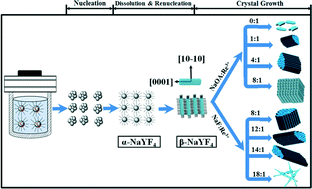Hydrothermal synthesis of ordered β-NaYF4 nanorod self-assemblies with multicolor up- and down-conversions†
Abstract
Ordered β-NaYF4 nanorod self-assemblies with controllable morphologies and tunable sizes have been successfully synthesized via a facile hydrothermal route. X-ray diffraction (XRD), scanning electron microscopy (SEM), transmission electron microscopy (TEM), high-resolution transmission electron microscopy (HRTEM), and photoluminescence (PL) spectra were used to characterize the samples. The influences of the molar ratio of sodium oleate (NaOA) to RE3+ and NaF to RE3+ (RE represents the total amount of Y3+ and the doped rare earth elements such as Eu3+, Tb3+, Sm3+, Yb3+, Er3+, Tm3+, and Ho3+) on the crystal morphology and size have been investigated in detail. It is found that NaOA and NaF have a dynamic effect by adjusting the growth rate of different facets under different experimental conditions, resulting in the formation of the anisotropic geometries of various β-NaYF4 crystals. The possible formation mechanism for products with diverse morphologies has been proposed. The luminescence properties and mechanisms for the doped β-NaYF4:Ln3+ (Ln = Eu, Tb, Sm, Yb/Er, Yb/Tm, and Yb/Ho) crystals were thoroughly analyzed. Multicolor emissions, including red, green, orange, and blue, can be achieved in ordered β-NaYF4:Ln3+ nanorod self-assemblies by simply changing the dopant species (Ln3+).


 Please wait while we load your content...
Please wait while we load your content...